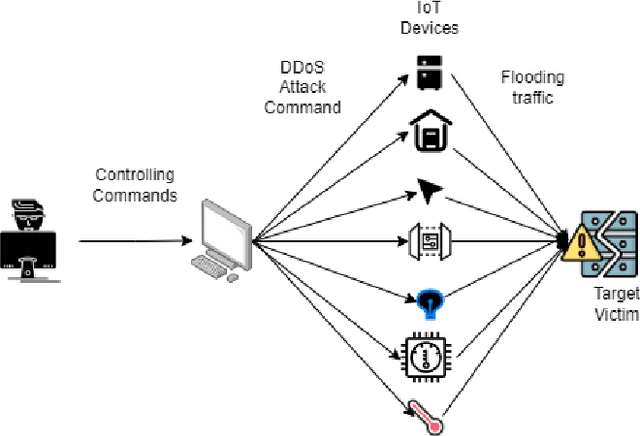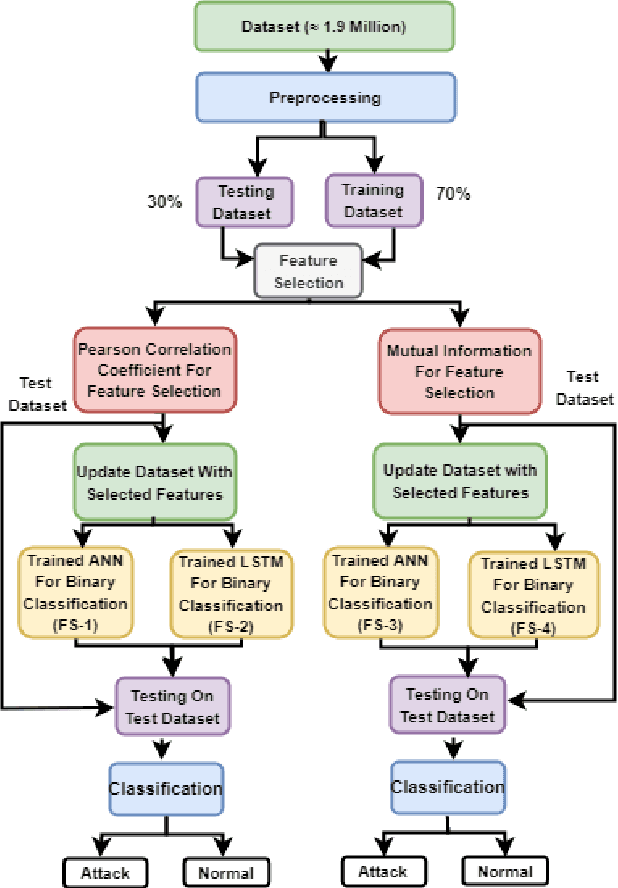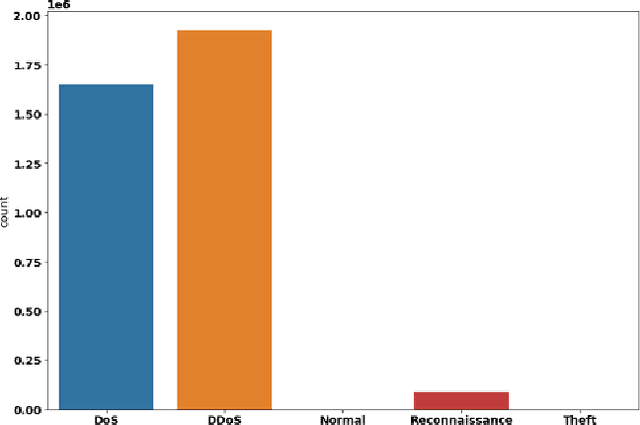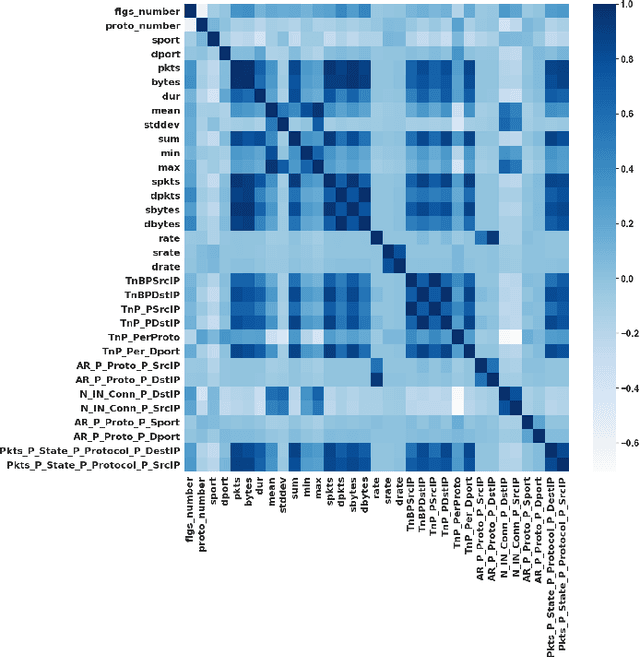O. P. Vyas
Indian Institute of Information Technology, Allahabad, India
NFDLM: A Lightweight Network Flow based Deep Learning Model for DDoS Attack Detection in IoT Domains
Jul 15, 2022



Abstract:In the recent years, Distributed Denial of Service (DDoS) attacks on Internet of Things (IoT) devices have become one of the prime concerns to Internet users around the world. One of the sources of the attacks on IoT ecosystems are botnets. Intruders force IoT devices to become unavailable for its legitimate users by sending large number of messages within a short interval. This study proposes NFDLM, a lightweight and optimised Artificial Neural Network (ANN) based Distributed Denial of Services (DDoS) attack detection framework with mutual correlation as feature selection method which produces a superior result when compared with Long Short Term Memory (LSTM) and simple ANN. Overall, the detection performance achieves approximately 99\% accuracy for the detection of attacks from botnets. In this work, we have designed and compared four different models where two are based on ANN and the other two are based on LSTM to detect the attack types of DDoS.
LBDMIDS: LSTM Based Deep Learning Model for Intrusion Detection Systems for IoT Networks
Jun 23, 2022



Abstract:In the recent years, we have witnessed a huge growth in the number of Internet of Things (IoT) and edge devices being used in our everyday activities. This demands the security of these devices from cyber attacks to be improved to protect its users. For years, Machine Learning (ML) techniques have been used to develop Network Intrusion Detection Systems (NIDS) with the aim of increasing their reliability/robustness. Among the earlier ML techniques DT performed well. In the recent years, Deep Learning (DL) techniques have been used in an attempt to build more reliable systems. In this paper, a Deep Learning enabled Long Short Term Memory (LSTM) Autoencoder and a 13-feature Deep Neural Network (DNN) models were developed which performed a lot better in terms of accuracy on UNSW-NB15 and Bot-IoT datsets. Hence we proposed LBDMIDS, where we developed NIDS models based on variants of LSTMs namely, stacked LSTM and bidirectional LSTM and validated their performance on the UNSW\_NB15 and BoT\-IoT datasets. This paper concludes that these variants in LBDMIDS outperform classic ML techniques and perform similarly to the DNN models that have been suggested in the past.
Agricultural Plantation Classification using Transfer Learning Approach based on CNN
Jun 19, 2022



Abstract:Hyper-spectral images are images captured from a satellite that gives spatial and spectral information of specific region.A Hyper-spectral image contains much more number of channels as compared to a RGB image, hence containing more information about entities within the image. It makes them well suited for the classification of objects in a snap. In the past years, the efficiency of hyper-spectral image recognition has increased significantly with deep learning. The Convolution Neural Network(CNN) and Multi-Layer Perceptron(MLP) has demonstrated to be an excellent process of classifying images. However, they suffer from the issues of long training time and requirement of large amounts of the labeled data, to achieve the expected outcome. These issues become more complex while dealing with hyper-spectral images. To decrease the training time and reduce the dependence on large labeled data-set, we propose using the method of transfer learning.The features learned by CNN and MLP models are then used by the transfer learning model to solve a new classification problem on an unseen dataset. A detailed comparison of CNN and multiple MLP architectural models is performed, to determine an optimum architecture that suits best the objective. The results show that the scaling of layers not always leads to increase in accuracy but often leads to over-fitting, and also an increase in the training time.The training time is reduced to greater extent by applying the transfer learning approach rather than just approaching the problem by directly training a new model on large data-sets, without much affecting the accuracy.
Terrain Classification using Transfer Learning on Hyperspectral Images: A Comparative study
Jun 19, 2022



Abstract:A Hyperspectral image contains much more number of channels as compared to a RGB image, hence containing more information about entities within the image. The convolutional neural network (CNN) and the Multi-Layer Perceptron (MLP) have been proven to be an effective method of image classification. However, they suffer from the issues of long training time and requirement of large amounts of the labeled data, to achieve the expected outcome. These issues become more complex while dealing with hyperspectral images. To decrease the training time and reduce the dependence on large labeled dataset, we propose using the method of transfer learning. The hyperspectral dataset is preprocessed to a lower dimension using PCA, then deep learning models are applied to it for the purpose of classification. The features learned by this model are then used by the transfer learning model to solve a new classification problem on an unseen dataset. A detailed comparison of CNN and multiple MLP architectural models is performed, to determine an optimum architecture that suits best the objective. The results show that the scaling of layers not always leads to increase in accuracy but often leads to overfitting, and also an increase in the training time.The training time is reduced to greater extent by applying the transfer learning approach rather than just approaching the problem by directly training a new model on large datasets, without much affecting the accuracy.
Semi-Automatic Terminology Ontology Learning Based on Topic Modeling
Aug 05, 2017



Abstract:Ontologies provide features like a common vocabulary, reusability, machine-readable content, and also allows for semantic search, facilitate agent interaction and ordering & structuring of knowledge for the Semantic Web (Web 3.0) application. However, the challenge in ontology engineering is automatic learning, i.e., the there is still a lack of fully automatic approach from a text corpus or dataset of various topics to form ontology using machine learning techniques. In this paper, two topic modeling algorithms are explored, namely LSI & SVD and Mr.LDA for learning topic ontology. The objective is to determine the statistical relationship between document and terms to build a topic ontology and ontology graph with minimum human intervention. Experimental analysis on building a topic ontology and semantic retrieving corresponding topic ontology for the user's query demonstrating the effectiveness of the proposed approach.
 Add to Chrome
Add to Chrome Add to Firefox
Add to Firefox Add to Edge
Add to Edge